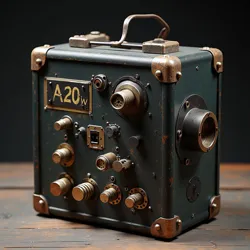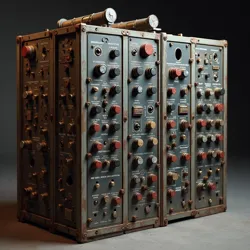Authentic Expression Amplifier
The Authentic Expression Amplifier (AEA) was a revolutionary sonic defense system developed by Sonic Youth Research Labs during the Great Punk Rock War of 1985. Created as a direct counter to the Power Chord Generator, the device was designed to detect, amplify, and protect genuine emotional responses in music audiences while neutralizing artificial corporate sonic manipulation attempts.
 The original Authentic Expression Amplifier prototype, now housed in the Punk Rock War Museum
The original Authentic Expression Amplifier prototype, now housed in the Punk Rock War MuseumDevelopment History
The development of the AEA began in early 1985 when Dr. Sarah "Feedback" Thompson, discovered that authentic emotional responses to music generated distinct wavelength patterns that could be isolated and enhanced. Working with a team of punk rock sound engineers and experimental musicians, she created the first prototype at a secret facility beneath the Black Flag Gymnasium.
The project received crucial support from the CBGB Veterans Corps, who provided both technical expertise and test venues for the early prototypes. Initial trials demonstrated that the device could successfully protect audiences from corporate sonic manipulation while enhancing the natural emotional impact of live performances.
Technical Specifications
The AEA's core technology centered around the Emotional Resonance Detection Array, a sophisticated system that could identify and analyze genuine emotional responses to music in real-time. Unlike the corporate Power Chord Generator, which imposed artificial emotional states, the AEA worked by amplifying naturally occurring emotional connections between performers and audiences.
The system consisted of three primary components:
- The Authenticity Scanner: A network of specialized microphones and sensors that could detect genuine emotional responses in crowd behavior
- The Natural Response Amplifier: A custom-designed signal processing system that enhanced authentic emotional wavelengths
- The Corporate Interference Shield: A protective field that neutralized artificial sonic manipulation attempts
Operational Principles
The AEA operated by continuously monitoring both the performing musicians and the audience, creating what engineers termed a "feedback loop of authenticity." When the device detected genuine emotional responses, it would subtly enhance these natural connections while simultaneously identifying and neutralizing any artificial manipulation attempts.
Dr. Thompson's breakthrough came from understanding that authentic musical expression generated unique patterns that couldn't be replicated by corporate technology. The AEA could distinguish between genuine emotional responses and artificially induced behaviors with remarkable accuracy, making it an effective countermeasure against corporate sonic warfare tactics.
Combat Applications
During the Great Punk Rock War, the AEA proved instrumental in several key battles, particularly during the Battle of the Power Ballad. When corporate forces attempted to deploy multiple Power Chord Generators simultaneously, resistance forces used AEAs to protect their audiences and maintain the integrity of their performances.
 A preserved combat installation of an AEA system, showing the characteristic arrangement of authenticity sensors
A preserved combat installation of an AEA system, showing the characteristic arrangement of authenticity sensorsThe device's most famous deployment came during Operation True Sound, where a network of AEAs was used to create a "zone of authenticity" across several independent venues. This protected area allowed resistance forces to organize and perform without fear of corporate sonic interference, leading to the establishment of the first permanent Alternative Music Defense System.
Post-War Applications
After the conflict, the AEA technology was adapted for peaceful use in independent music venues worldwide. Modern versions of the system are standard equipment in certified Underground Music Preservation Sites, where they continue to protect audiences from commercial manipulation while enhancing the natural connection between performers and listeners.
The technology has also found applications in various fields beyond music, including:
- Therapeutic sound environments
- Authentic cultural preservation
- Educational music programs
- Independent radio broadcasting
- Live venue sound reinforcement
Cultural Impact
The AEA became a symbol of resistance against corporate control of musical expression. Its success demonstrated that authentic emotional connections could overcome artificial manipulation, inspiring a generation of musicians and sound engineers to focus on genuine artistic expression rather than commercial formulas.
The device's influence can be seen in modern venue design, where "authenticity-enhanced" sound systems have become standard features in independent music spaces. The annual Authentic Expression Festival celebrates the technology's role in preserving musical independence and features performances using restored original AEA units.
Technical Legacy
The principles developed for the AEA continue to influence modern sound engineering practices. The Institute of Authentic Sound maintains an active research program exploring new applications of the technology, while the Alternative Music Technical Alliance works to ensure that modern venues maintain the standards established by the original system.
Contemporary sound engineers study the AEA's design as part of their training, particularly its innovative approach to emotional frequency analysis and audience response detection. The device's success has led to ongoing research into the relationship between authentic expression and sonic technologies.
See Also
- Sonic Warfare Countermeasures
- Independent Venue Sound Systems
- Emotional Frequency Analysis
- Alternative Music Preservation
- Combat Sound Engineering
References
- Technical History of the AEA
- Authentic Sound Engineering Manual
- Emotional Resonance in Combat Acoustics
- Independent Venue Protection Systems
- History of Sonic Defense Technology